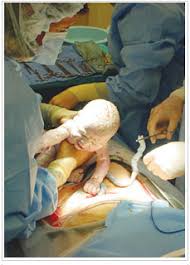January 11th, 2011 by Linda Burke-Galloway, M.D. in Better Health Network, Health Tips
No Comments »

 Although I’ve been a proponent for the prevention of medical errors for years and wrote a book to address those issues, I think my obstetrician-gynecologist (OB/GYN) colleagues are finally catching on.
Although I’ve been a proponent for the prevention of medical errors for years and wrote a book to address those issues, I think my obstetrician-gynecologist (OB/GYN) colleagues are finally catching on.
Dr. Patrick Duff of the University of Florida’s OB/GYN department wrote an article in the December issue of the journal Obstetrics & Gynecology that caught my attention. In his article, “A Simple Checklist for Preventing Major Complications Associated with Cesarean Delivery,” Duff outlines steps that OB/GYNs should take in order to reduce complications during and after a cesarean section. Duff patterns his list after Dr. Atul Gawande’s book, “The Checklist Manifesto: How to Get it Right,” which has set the standard regarding reducing complications after surgery. According to Duff, the following steps should be taken in order to reduce complications after a cesarean section:
1. Clip hair at the surgical site just before making the incision to reduce wound infections. Duff states that there is a greater chance of promoting infections when the hair is shaved the night before the procedure. He also recommends clipping hair as opposed to shaving which reduces the rate of would infections.
2. Cleanse skin with chlorhexidine solution rather than iodine because medical studies have demonstrated a reduction in infections using chlorhexidine solution.
3. Give broad spectrum antibiotics before the surgical incision as opposed to after the newborn’s umbilical cord is clamped. Read more »
*This blog post was originally published at Dr. Linda Burke-Galloway*
April 13th, 2010 by Medgadget in Better Health Network, Health Tips, News, Opinion, Research
No Comments »

 Researchers at the University of Florida in Gainesville have developed a vitamin E-secreting contact lens that can bring the valuable antioxidant directly to eyes.
Researchers at the University of Florida in Gainesville have developed a vitamin E-secreting contact lens that can bring the valuable antioxidant directly to eyes.
Vitamin E is packaged into clusters within the lens and the aggregate works to slowly release the chemical while remaining invisible to the eye.
“These vitamin structures are like ‘nanobricks’,” said Anuj Chauhan, Ph.D., lead researcher of the study. “The drug molecules can’t go through the vitamin E. They must go around it. Because the nanobricks are so much bigger than the drug molecules -– we believe about a few hundred times bigger –- the molecules get diverted and must travel a longer path. This increases the duration of the drug release from the lenses.” Read more »
*This blog post was originally published at Medgadget*
April 8th, 2010 by Medgadget in Better Health Network, News, Research
1 Comment »

 University of Florida researchers have developed a signaling technology that can be embedded into drug tablets to notify clinicians and caretakers that a pill has been ingested.
University of Florida researchers have developed a signaling technology that can be embedded into drug tablets to notify clinicians and caretakers that a pill has been ingested.
Although a bit of electronics is going to be moving through the digestive system, the researchers believe that it will pass safely without causing side effects to the patient.
If the technology proves itself, it may soon be used to confirm compliance in clinical trials or to monitor patients under a strict drug regimen.
One part is the pill, a standard white capsule coated with a label embossed with silvery lines. The lines comprise the antenna, which is printed using ink made of non-toxic, conductive silver nanoparticles. The pill also contains a tiny microchip, one about the size of a period on paper. Read more »
*This blog post was originally published at Medgadget*
March 9th, 2010 by RyanDuBosar in Better Health Network, News
No Comments »

Doctors at the University of Florida invented a device that sniffs employees’ hands for soap residue to check whether they’ve washed them enough.
After employees wash their hands, they pass them under the sniffer and their badge activates. When they later approach a patient, a bed-side monitor reads the badge and flashes green if the person has clean hands. If the person didn’t wash or too much time has passed since they have, the badge vibrates to remind the employee.
We’d already covered bathing hands with plasma instead of soap. Don’t get those near the sniffer.

*This blog post was originally published at ACP Hospitalist*
Although I’ve been a proponent for the prevention of medical errors for years and wrote a book to address those issues, I think my obstetrician-gynecologist (OB/GYN) colleagues are finally catching on.




 Researchers at the University of Florida in Gainesville have developed a vitamin E-secreting contact lens that can bring the valuable antioxidant directly to eyes.
Researchers at the University of Florida in Gainesville have developed a vitamin E-secreting contact lens that can bring the valuable antioxidant directly to eyes. University of Florida researchers have developed a signaling technology that can be embedded into drug tablets to notify clinicians and caretakers that a pill has been ingested.
University of Florida researchers have developed a signaling technology that can be embedded into drug tablets to notify clinicians and caretakers that a pill has been ingested.








